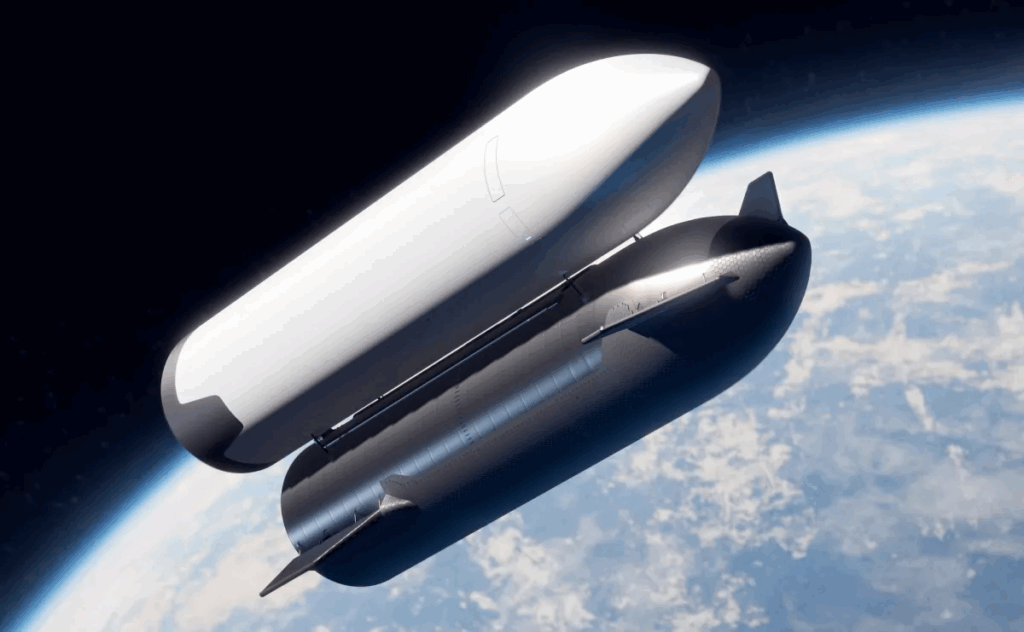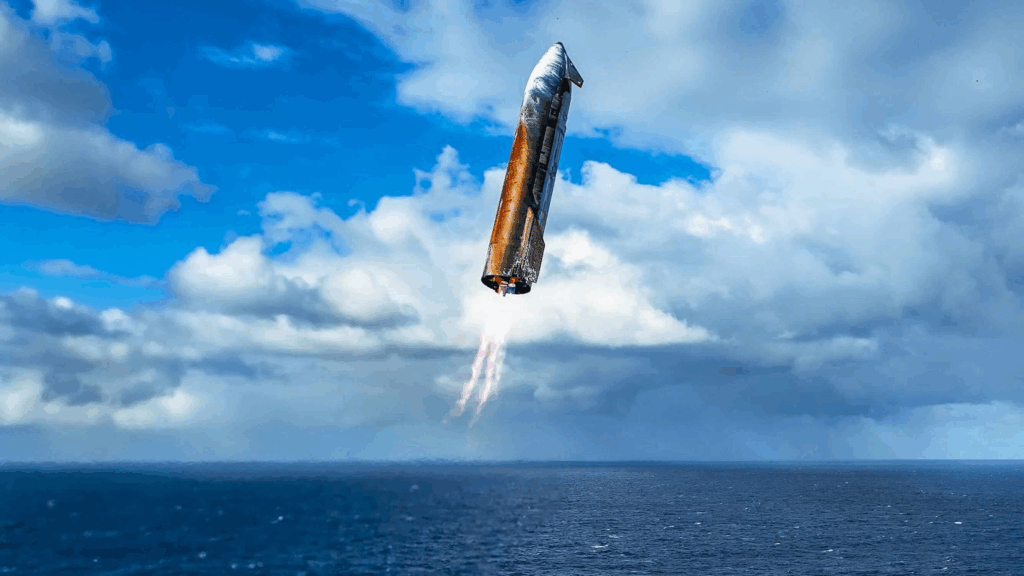SpaceX bounces back after failed Starship flight tests in Flight 10 and 11
When Elon Musk is not implementing efficiency into the U.S. government, he can sometimes be spotted launching rockets. A recent test of Starship, a rocket being developed by Musk’s space technology company SpaceX, inched humanity a little closer to returning to the Moon again.
Starship is Musk and SpaceX’s vehicle for the future, meant to be a fully reusable transportation system that can carry crew and cargo into orbit, to the Moon, Mars, and beyond. On Earth, its reusability would also open the doors to a point-to-point transportation system that could let passengers travel anywhere on Earth in one hour or less. Importantly, it is also the vehicle that will bring humans back to the Moon as part of Artemis (1).

A render of what an in-space refueling of the Starship vehicle could look like
Artemis is the National Aeronautics and Space Administration’s (NASA) program that aims to return human life to the Moon, which has not occurred since the conclusion of the Apollo program. NASA has chosen SpaceX to be the provider of the Human Landing System (HLS), the vehicle that will bring astronauts the final step of the way onto the surface of the Moon. Astronauts aboard the Orion spacecraft will first take off from Earth aboard NASA’s Space Launch System (SLS) and reach the Moon’s orbit before transferring into a specialized version of SpaceX’s Starship vehicle, which will then bring them down to the Moon’s surface (2).
Artemis I, the first test in the Artemis series, occurred at the end of 2022, when the SLS and Orion were sent around the Moon to stress systems and test equipment in preparation for future crewed missions (3). Artemis II, planned for April 2026, will take four astronauts around the Moon to continue tests of critical systems and ship maneuvering operations. After separating from the SLS’s upper stage, the Interim Cryogenic Propulsion Stage (ICPS), Orion will use the ICPS as a docking target in space to test its maneuvering capabilities. The astronauts on board will practice docking and undocking operations by lining up with, approaching, and then backing away from the ICPS (4).

Orion will be the spacecraft that brings astronauts from Earth into the Moon’s orbit
Artemis III, currently planned for mid-2027, will set humans back down on the Moon for the first time in over 50 years thanks to the Starship HLS. Before transporting any humans, SpaceX will do at least one uncrewed demonstration mission of Starship on the Moon. To reach the Moon, SpaceX will launch storage depots into Earth’s orbit, which will store fuel brought up by reusable tankers. Then, an uncrewed Starship will launch into orbit, rendezvous with the storage depot, and fuel up before heading to the Moon (5).
NASA will place Orion in a near-rectilinear halo orbit (NRHO) around the Moon, an orbit that is gravitationally balanced between Earth and the Moon and will maximize fuel efficiency. Engineers also chose the orbit for its near-constant communication access with Earth and access to sites all over the Moon. Once Orion and Starship are both in NRHO, they will dock together, allowing two of the four astronauts of the Artemis III mission to board before the two spacecraft undock from each other (5).
The two pairs of astronauts will spend about 6.5 days separated, roughly the length of one orbit around the Moon, where the two-person surface crew lands on the Moon to carry out expeditions. On the surface, the astronauts will take pictures and video, survey geology, retrieve rock samples, and collect other data to bring back to Earth. Wearing spacesuits designed by Axiom Space, the crew will exit through Starship’s airlock and descend via its elevator to conduct the space walks (5).
In the future, NASA will place a lunar space station called Gateway in NRHO, which will serve as a base for living and working and conducting long-term science and human exploration on and around the Moon (2, 5). However, the first few Artemis missions will only utilize Orion and Starship.
Currently, SpaceX is still developing Starship, and it is not yet ready for Artemis. On August 26, 2025, Starship Flight 10 lifted off from its base in Texas as part of its tenth flight test. The test was a success, with the mission meeting every major objective and collecting the critical data necessary to inform future Starship designs. In the first successful payload demonstration of Starship, the vehicle also deployed eight dummy payloads to space, paving the way for future cargo deliveries (6). The successful test was a bounce-back for SpaceX, which had lost the spacecraft prematurely during the previous three flight tests (7).

An orange hue caused by the oxidized metallic tiles can be seen as Starship Flight 10 touched down
The flight test examined the use of metallic heat shield tiles, which are used to protect the spacecraft from the extreme temperatures of up to 2,600 °F during reentry. While metal tiles would be simpler to manufacture and more durable than the traditional ceramic tiles typically used for heat shielding, the metal tiles did not perform as well, oxidizing in the high-oxygen environment and leaving a rusty orange hue down the side of the entire Starship. Additionally, gaps between the heat shield tiles let in heat, which eroded the underlying ship material (8).
In the following flight test, Flight 11, which launched on October 13, 2025, SpaceX used an experimental material called “crunch wrap” to go in between the tiles and secure them to the spacecraft body (8, 9). Being an all-around mission success, Flight 11 concluded the final rounds of tests for the current Version 2 of Starship. It trialed engine configurations planned for use in Version 3 of Starship, which will contain new ship capabilities along with improved engines and shielding (9)
While the tests aren’t directly specific to the Starship HLS, SpaceX will have to work out the details of Starship before any humans set foot on another celestial body, whether the Moon or Mars. However, little by little, through successes and failures, Starship is bringing human space exploration back within reach.
References
- SpaceX. (2025). Starship. SpaceX. https://www.spacex.com/vehicles/starship
- NASA, & Daines, G. (2025, March 14). Artemis. NASA. https://www.nasa.gov/feature/artemis/
- Ridgeway, B. (2022, December 11). Splashdown! NASA’s Orion Returns to Earth After Historic Moon Mission. NASA. https://www.nasa.gov/centers-and-facilities/hq/splashdown-nasas-orion-returns-to-earth-after-historic-moon-mission/
- Hambleton, K. (2025, April 8). NASA’s First Flight With Crew Important Step on Long-term Return to the Moon, Missions to Mars. NASA. https://www.nasa.gov/missions/artemis/nasas-first-flight-with-crew-important-step-on-long-term-return-to-the-moon-missions-to-mars/
- Williams, C. (2023, January 13). Artemis III: NASA’s First Human Mission to Lunar South Pole. NASA. https://www.nasa.gov/missions/artemis/artemis-iii/
- SpaceX. (2025, August 26). Starship’s Tenth Flight Test. SpaceX. https://www.spacex.com/launches/starship-flight-10
- Wall, M. (2025, September 23). SpaceX fires up Starship spacecraft ahead of 11th test flight (video). Space. https://www.space.com/space-exploration/launches-spacecraft/spacex-fires-up-starship-spacecraft-ahead-of-11th-test-flight-video
- Clark, S. (2025, September 9). SpaceX’s lesson from last Starship flight? “We need to seal the tiles.” Ars Technica. https://arstechnica.com/space/2025/09/spacexs-lesson-from-last-starship-flight-we-need-to-seal-the-tiles/
- SpaceX. (2025, October 13). Starship’s Eleventh Flight Test. SpaceX. https://www.spacex.com/launches/starship-flight-11










Comments are closed.